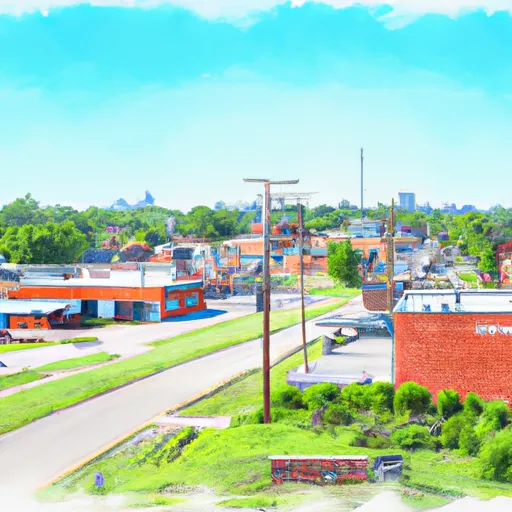-
 Snoflo Premium
Snoflo Premium
Get unlimited access to all our content
With no Ad interruptions! - Start Your Free Trial Login with existing account
Ward
Eden Index
Climate
7.9
•
Recreation
2.9
•
Community
0.9
•
Safeguard
4.4/10

Ward, Arkansas is a charming city located in Lonoke County. The climate in Ward is considered to be humid subtropical, characterized by hot summers and mild winters. Summers are typically hot and humid, with temperatures often reaching the 90s Fahrenheit. Winters are generally mild, with temperatures averaging in the 40s and occasional snowfall.
The hydrology constituents of Ward are primarily influenced by the Little Rock and Arkansas rivers, which flow through the region. These rivers provide recreational opportunities such as fishing, boating, and kayaking. The area is also dotted with numerous lakes and ponds, offering additional water-based activities.
Outdoor enthusiasts in Ward can enjoy various recreational opportunities. The city boasts several parks and green spaces, providing ample opportunities for hiking, picnicking, and sports. Additionally, the area is surrounded by pristine natural areas, allowing for camping, wildlife observation, and photography. Ward is also conveniently located near several wildlife management areas, where hunting and trapping are permitted during designated seasons.
Overall, Ward offers a pleasant climate, abundant hydrology constituents, and diverse outdoor recreation opportunities for residents and visitors alike.
What is the Eden Index?
The Snoflo Eden Index serves as a comprehensive rating system for regions, evaluating their desirability through a holistic assessment of climate health, outdoor recreation opportunities, and natural disaster risk, acknowledging the profound impact of these factors on livability and well-being.
Climate Health Indicator (CHI): 7.9
Ward receives approximately
1278mm of rain per year,
with humidity levels near 84%
and air temperatures averaging around
17°C.
Ward has a plant hardyness factor of
7, meaning
plants and agriculture in this region tend to thrive during the non-winter months.
By considering the ideal temperature range, reliable water supplies, clean air, and stable seasonal rain or snowpacks, the Climate Health Indicator (CHI) underscores the significance of a healthy climate as the foundation for quality living.
A healthy climate is paramount for ensuring a high quality of life and livability in a region, fostering both physical well-being and environmental harmony. This can be characterized by ideal temperatures, reliable access to water supplies, clean air, and consistent seasonal rain or snowpacks.
Weather Forecast
Streamflow Conditions
Lower White
Area Rivers
Lower White
Snowpack Depths
Lower White
Reservoir Storage Capacity
Lower White
Groundwater Levels
Recreational Opportunity Index (ROI): 2.9
The Recreational Opportunity Index (ROI) recognizes the value of outdoor recreational options, such as parks, hiking trails, camping sites, and fishing spots, while acknowledging that climate plays a pivotal role in ensuring the comfort and consistency of these experiences.
Access to outdoor recreational opportunities, encompassing activities such as parks, hiking, camping, and fishing, is crucial for overall well-being, and the climate plays a pivotal role in enabling and enhancing these experiences, ensuring that individuals can engage in nature-based activities comfortably and consistently.
Camping Areas
| Campground | Campsites | Reservations | Toilets | Showers | Elevation |
|---|---|---|---|---|---|
| Chemin - A - Haut State Park | None | 125 ft | |||
| Rising Star | None | 196 ft | |||
| Trulock - Arkansas River | 15 | 195 ft | |||
| Saracen Trace RV Park | 52 | 217 ft | |||
| Crossett RV Park | 119 | 68 ft | |||
| Acadiana Park | 75 | 42 ft | |||
| Opelousas City RV Park | 67 | 64 ft | |||
| Cypremort Point State Park | None | 3 ft | |||
| Grand Marais County Park | None | 79 ft | |||
| Cane Creek State park | None | 257 ft |
Nearby Ski Areas
Catastrophe Safeguard Index (CSI):
The Catastrophe Safeguard Index (CSI) recognizes that natural disaster risk, encompassing floods, fires, hurricanes, and tornadoes, can drastically affect safety and the overall appeal of an area.
The level of natural disaster risk in a region significantly affects safety and the overall livability, with climate change amplifying these risks by potentially increasing the frequency and intensity of events like floods, fires, hurricanes, and tornadoes, thereby posing substantial challenges to community resilience and well-being.
Community Resilience Indicator (CRI): 0.9
The Community Resilience Indicator (CRI) recognizes that education, healthcare, and socioeconomics are crucial to the well-being of a region. The CRI acknowledges the profound impact of these elements on residents' overall quality of life. By evaluating educational resources, healthcare accessibility, and economic inclusivity, the index captures the essential aspects that contribute to a thriving community, fostering resident satisfaction, equity, and social cohesion.

